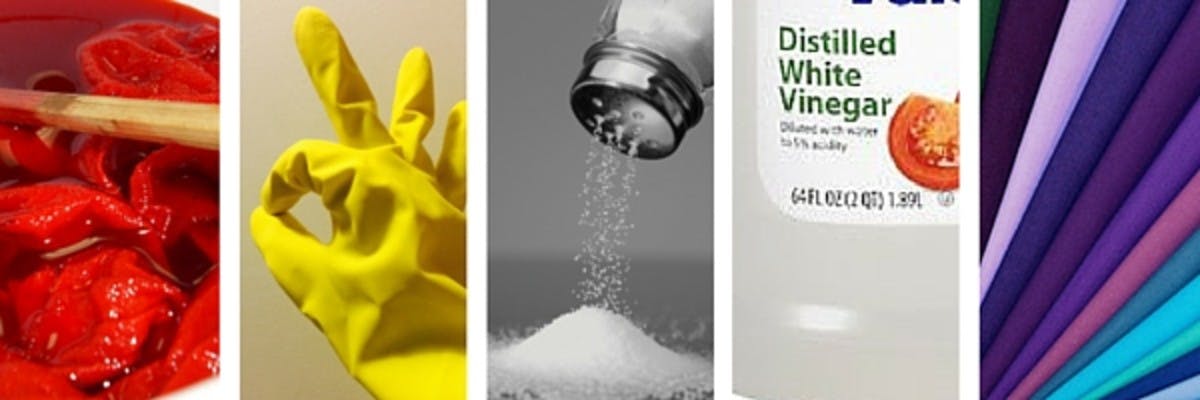One of my favorite ways to create a fierce new outfit for a special occasion is to repurpose something I already own! This saves money, gives me an opportunity to be creative and crafty, and gives a fashion facelift to a perfectly good garment that may not be receiving enough love from me. One of the easiest, yet most drastic ways to do this is to bust out the fabric dye! I happen to be attending a fancy Oscars viewing party in a couple weeks and as an experiment, my style savvy friend and I decided to try dyeing an old, grungy, off-white cocktail dress a deep purple with the hopes that it would be worthy for such a party. The results exceed my wildest expectations and inspired me to share the best practices I have learned with you! So without further ado, on this week’s episode of Fashion Facelift: tips for dyeing fabric!

Pick your poison
For starters, some fabrics will take dye better than others. Obviously. The best materials to use are:
- Natural fabrics such as 100% cotton, linen, silk, wool, or ramie
- Synthetic fabrics such as rayon and nylon
- Blends of at least 60% cotton or other dyeable fiber
Less dyeable materials to use are:
- 100% polyester, acrylic, acetate, fiberglass, spandex and metallic fibers
- Waterproofed (or other coated) fabrics
- Bleach damaged or extensive staining
- “Dry clean only” or can only be washed in cold water
Prep your area and yourself:
As you can imagine, fabric dye stains more than just fabric. I have learned the hard way that fabric dye takes several showers to come out of the skin, and is a hopeless case on a porcelain sink or a linoleum floor. So grab the plastic tarp for the floor. Put on clothes you don’t mind ruining. Get yourself some rubber gloves. Use a plastic or metal bucket/pot, and keep the bleach all-purpose cleaner handy for immediate clean up of any accidental spills.
Prep your fabric:
Dye will take best to white or almost white fabric. If your garment or fabric is already a bright color, consider bleaching it first to create an even base. This will also help take care of any stains or patterns that may show through the dye.
Test it out:
No matter how confident you are in your fabric choice, try dyeing a small swatch of the fabric before you go all-in and dye the whole garment. No need to waste all those materials if the fabric will not take the dye with the evenness or intensity that you are looking for.
Use enough dye:
Seems self-explanatory, but be sure you use the dye and other ingredients in the appropriate amounts as indicated on the bottle. Otherwise, your fabric may end up splotchy (not enough dye), or you’re just being wasteful (too much dye). More dye does not necessarily equate to more color. Read on for ways to deepen and intensify your color!
Use HOT water:
For the deepest color, use a water temperature of 140ºF/60ºC. Don’t worry, you’ll be able to handle it. That’s about the temperature of your morning latte, and nowhere near the boiling point.
Add-ins:
As promised, there are a few things you can do to boost the intensity of your color, depending on the fabric.
- Salt: Add 1 cup to the dye solution for fabrics containing cotton, rayon, ramie, or linen
- White vinegar: Add 1 cup to the dye solution for fabrics containing nylon silk and wool. Add about five minutes after the fabric has been submerged.
- Laundry detergent: Add 1 tablespoon to ALL dye baths. This is very helpful in making the color take evenly.
Rinse and repeat:
First rinse your fabric in warm (not hot) water, then in cool water until it runs clear. Then machine washes the fabric/garment in warm water with mild detergent and use a cool rinse cycle. It is best to air dry your freshly dyed fabric as opposed to machine drying it.
Aftercare:
Like a good dye job for your hair, proper aftercare is essential to keep the finished product looking lustrous and new. Always wash your dyed garment in cool water with a non-bleaching detergent, by itself for the first few items of washing, then with like colors. Be sure to dry-clean any fabrics that would ordinarily require it.
Oh my God, my kitchen/bathroom/laundry room!:
So unless you’re Superman, some spills and stains probably happened. Occupational hazard. Clean surfaces and containers with hot water and powdered bleach. Your washing machine likely took a bit of a beating too, so clean it with the hottest, highest water cycle and add one cup each of laundry detergent and chlorine bleach to the water.
Voilà! A fashion facelift deserves a little recognition. Why not add a stylish woven label to your new garment to make it like new! Comment below with YOUR helpful dyeing tips!












